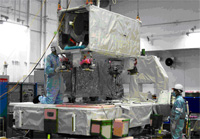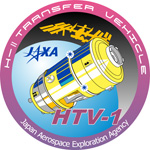The HTV-1 Mission is the first flight of the H-II Transfer Vehicle (HTV) that is designed, developed and built in Japan.
This is an archive of information released in the past.
Disclaimer: It may contain broken links or outdated information. Some parts may not function in current web browsers.
*Visit https://humans-in-space.jaxa.jp/en/ for the latest information.

H-II Transfer Vehicle KOUNOTORI (HTV)
HTV-1 Mission
News
HTV Exposed Pallet returned back into HTV Unpressurized Logistics Carrier (September 26, 2009)
The EP was unberthed from Kibo's Exposed Facility (EF) with Kibo's robotic arm (JEMRMS) at 6:07 p.m. September 25. The EP was then handed off to the station's robotic arm (SSRMS) from the JEMRMS, and at 10:20 p.m., the EP was reinstalled into the ULC with the SSRMS.
SMILES and HREP installed on Kibo's Exposed Facility (September 25, 2009)
Transfer and installation of two scientific payloads, SMILES and HREP, on Kibo's Exposed Facility (EF) was completed on Flight Day 15 (FD15).
The HTV Exposed Pallet installed on Kibo's Exposed Facility (September 24, 2009)
The cargo transfer activities between the HTV Pressurized Logistics Carrier (PLC) and the ISS have moved into full-swing from Flight Day 12 (FD12), September 21. On Flight Day 14 (FD14), September 23, the HTV Exposed Pallet (EP) was installed on Kibo's Exposed Facility (EF).
*All times are Japan Standard Time (JST)
The purpose of HTV-1 Mission
The HTV-1 Mission, HTV’s first flight to the ISS, has two major objectives: one is to deliver supplies to the ISS and the other is to verify HTV's rendezvous flight techniques and operability of the HTV onboard systems during its actual flight. For this reason, this HTV maiden flight vehicle is also called a "Technical Demonstration Vehicle". The HTV-1 Mission will perform the following technical/engineering demonstrations while transporting supplies and cargo to the ISS:
- Demonstration of HTV’s rendezvous flight operations
- Verification of HTV’s safety and flight control technology
- Demonstration of durability and robustness of the HTV structures on orbit
- Verification of HTV’s avionics and propulsion system components (more than 800,000 parts)
- Demonstration of astronaut’s ingress to the HTV pressurized section during the docked phase
Payload

SMILES loaded to the EP
The HTV-1 Mission will deliver approximately 4.5 tons of cargo to the ISS.
On the HTV-1 Mission, the HTV will carry additional propellants and batteries since demonstration tests are scheduled during the mission. Therefore, the cargo carried on the HTV-1 Mission is less than the standard mass capacity of the HTV.
Schedule
| Mission Details | ||
|---|---|---|
| HTV Flight Number | HTV-1 (maiden flight) | |
| Vehicle | Technical Demonstration Vehicle | |
| Launch | September 11, 2009 2:01 a.m. (JST) | |
| Launch Site | Launch Pad 2 (LP2), Tanegashima Space Center (TNSC) | |
| Capture by the SSRMS | September 18, 2009 4:51 a.m. (JST) | |
| Berthing to the ISS | September 18, 2009 7:27 a.m. (JST) | |
| Unberthing by the SSRMS | October 31, 2009 0:02 a.m. (JST) | |
| Separation from the ISS | October 31, 2009 2:32 a.m. (JST) | |
| Reentry | November 2, 2009 6:26 a.m. approx. (JST) | |
| Mission Duration | Approx. 52 days | |
| Altitude | Insertion:200 km x 300 km (elliptical orbit) Rendezvous:Approx. 350 km |
|
| Inclination | 51.6 degrees | |
| Payload | Pressurized Logistics Carrier (PLC) |
Supplies for onboard use HTV Resupply Rack (HRR) x 7, Pressurized Section Resupply Rack (PSRR) x 1 |
| Unpressurized Logistics Carrier (ULC) |
SMILES (Japanese experiment) HREP (NASA’s experiment) |
|
| Copyright 2007 Japan Aerospace Exploration Agency | Site Policy |



